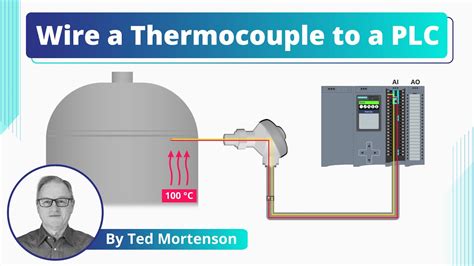How To Wire A Thermocouple
Ronan Farrow
Apr 03, 2025 · 3 min read

Table of Contents
How to Wire a Thermocouple: A Comprehensive Guide
Connecting a thermocouple might seem daunting, but with the right knowledge and careful execution, it's a manageable task. This guide will walk you through the process, covering various types, wiring techniques, and crucial safety precautions. Understanding thermocouple wiring is vital for accurate temperature measurement in various applications, from industrial processes to home brewing.
Understanding Thermocouples
Before diving into the wiring, let's briefly understand what a thermocouple is. A thermocouple is a sensor that measures temperature based on the Seebeck effect. This effect generates a small voltage difference when two dissimilar metals are joined at different temperatures. This voltage difference is directly proportional to the temperature difference, enabling accurate temperature readings.
Different types of thermocouples exist, each with its own unique metal composition, temperature range, and characteristics. Some common types include:
- Type K: A popular choice known for its wide temperature range, good stability, and relatively low cost.
- Type J: Another common type, suitable for a wide temperature range, but with lower accuracy at higher temperatures than Type K.
- Type T: Frequently used for low-temperature measurements.
- Type N: Offers excellent stability and oxidation resistance, suitable for high-temperature applications.
The choice of thermocouple depends on the specific application and the temperature range being measured. Always consult the thermocouple's datasheet for its specifications and wiring instructions.
Essential Tools and Materials
Before you begin wiring your thermocouple, ensure you have the following:
- Thermocouple: The specific type you need for your application.
- Wire strippers/cutters: To prepare the thermocouple wires.
- Soldering iron and solder: For a more secure and durable connection (optional, but recommended).
- Crimping tool: For use with crimp connectors (alternative to soldering).
- Crimp connectors: If using a crimp connection method.
- Multimeter: To test the continuity and functionality of the thermocouple circuit.
- Heat shrink tubing: Provides insulation and protection for the wire connections (optional, but recommended).
- Appropriate connector: This will depend on your application and the device you're connecting the thermocouple to. This could be a panel mount connector, screw terminal, or other specialized connector.
Wiring a Thermocouple: Step-by-Step Guide
The exact wiring procedure depends on the type of connector you're using. However, these general steps apply:
-
Prepare the wires: Carefully strip the insulation from the thermocouple wires, exposing a small length of the metal conductors. Be cautious not to damage the wires.
-
Connect the wires: Connect the thermocouple wires to the connector according to the color coding specified in the thermocouple's datasheet. Incorrect wiring will lead to inaccurate or erratic readings. Use soldering or crimp connectors for a secure connection.
-
Insulation: Apply heat shrink tubing to the connection to provide insulation and protection. Use a heat gun or lighter to shrink the tubing.
-
Test the connection: Use a multimeter to verify the continuity of the circuit.
-
Calibration (if necessary): Some applications might require calibrating the thermocouple to ensure accuracy. Consult the device's manual or the thermocouple's datasheet for the calibration procedure.
Common Mistakes to Avoid
-
Incorrect polarity: Connecting the wires in the wrong order will result in inaccurate readings. Always carefully follow the color code or the datasheet.
-
Damaged wires: Avoid damaging the thermocouple wires during stripping or connection. Damaged wires can affect the reading accuracy.
-
Poor connections: Loose or poorly made connections can lead to intermittent readings or complete failure. Use soldering or crimping to ensure a secure connection.
-
Neglecting insulation: Poor insulation can lead to short circuits or signal noise, affecting the readings. Always adequately insulate the connections.
Conclusion
Wiring a thermocouple might appear complex initially, but following the steps outlined above and exercising caution will ensure a successful connection. Remember to always consult the datasheet of your specific thermocouple and connector for detailed instructions and safety precautions. With the right tools, technique, and attention to detail, you can accurately measure temperature and confidently utilize your thermocouple in various applications.
Featured Posts
Also read the following articles
| Article Title | Date |
|---|---|
| How To Wire Downriggers | Apr 03, 2025 |
| How Wet Should Clothes Be After Washing | Apr 03, 2025 |
| Ayahuasca How To Make | Apr 03, 2025 |
| Howa Action For Sale | Apr 03, 2025 |
| Queen Of Cups How Someone Feels About You | Apr 03, 2025 |
Latest Posts
-
How Did John Martinez Die
Apr 04, 2025
-
How Did Jesus Handle Narcissists
Apr 04, 2025
-
How Did Jesus Defeat Death
Apr 04, 2025
-
How Did Jesse Masterpool Die
Apr 04, 2025
-
How Did Jeff Alessi Pass
Apr 04, 2025
Thank you for visiting our website which covers about How To Wire A Thermocouple . We hope the information provided has been useful to you. Feel free to contact us if you have any questions or need further assistance. See you next time and don't miss to bookmark.
